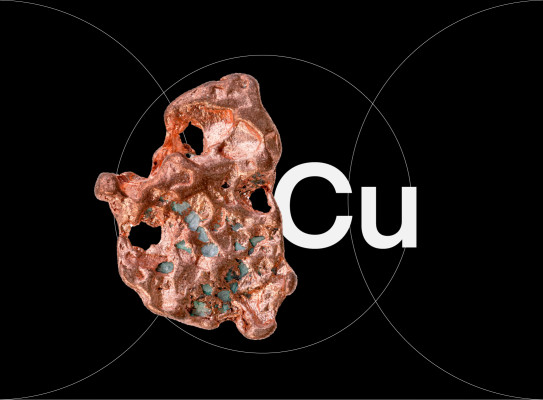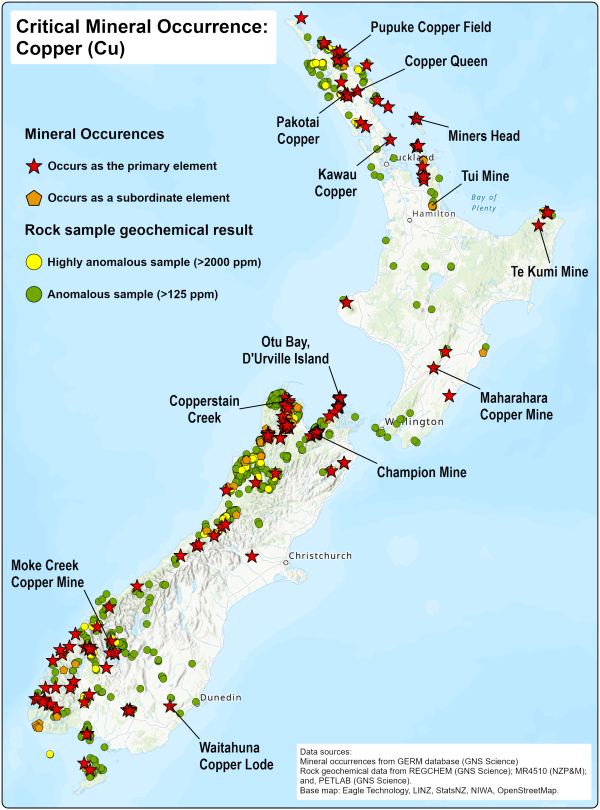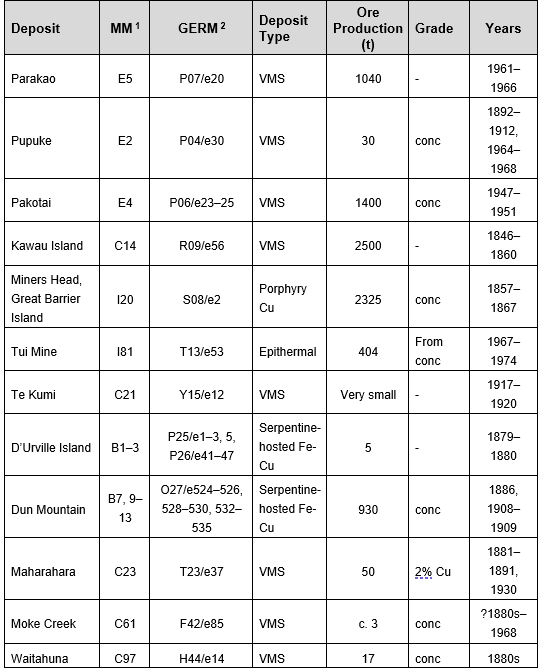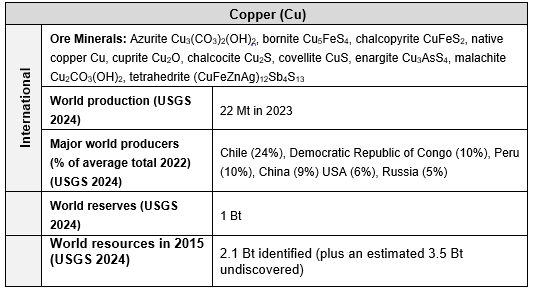Copper

Copper has been an essential material for human civilisation for thousands of years, valued for its unique properties such as high electrical and thermal conductivity, corrosion resistance, and malleability. Today, copper is more important than ever, underpinning modern technology, infrastructure, and the global transition to clean energy.
Copper in New Zealand
New Zealand has a wide variety of copper type deposits; these have been classified and grouped according to international mineral deposit models: porphyry Cu, porphyry Mo-Cu, volcanogenic massive sulphide (VMS), serpentine-hosted Fe-Cu, gabbroid-associated Ni-Cu, intermediate sulphidation epithermal Au, orogenic and copper skarn deposits. The primary origin and potential genetic classification of some quartz vein and disseminated stratabound/stratiform deposits, particularly in Fiordland, is difficult to determine because of insufficient information.
A little more than 7500 t of copper ore has been mined in New Zealand since the country’s first underground mine was opened on Kawau Island in 1842. This production was mainly from volcanogenic massive sulphide (Kawau Island, Pakotai, Pupke, Parakao, Te Kumi, Maharahara, Moke Creek, Waitahuna), serpentinite-hosted (Dun Mountain, D’Urville Island), hydrothermal (epithermal) vein (Tui Mine) and porphyry Cu (Miners Head, Great Barrier Island) deposits.


Why Copper is a Critical Element
Copper’s versatility and recyclability make it essential for technological advancement and sustainable development. As global demand for electrification and renewable energy grows, so does the need for copper. Key reasons copper is critical include:
- Essential for Clean Energy – Used in solar, wind, and hydroelectric systems.
- Supports Green Technologies – A key material for EVs, charging infrastructure, and smart grids.
- Foundational to Digital Connectivity – Integral to global communication networks and data transmission.
- Highly Recyclable – Nearly 80% of all copper ever mined is still in use today.
With increasing demand and limited high-grade deposits, ensuring a stable and responsible supply of copper is vital for the future of global infrastructure, energy, and technology.
Key uses of Copper
-
Electrical & Electronics
Copper is the most efficient non-precious metal conductor of electricity, making it fundamental to power generation and transmission.
- Used in electrical wiring, circuit boards, transformers, and motors.
- A key component in household appliances, telecommunications, and computing devices.
- Essential for batteries, particularly in electric vehicles (EVs) and energy storage solutions.
-
Construction & Infrastructure
Copper’s durability and resistance to corrosion make it indispensable in building and infrastructure development.
- Used in plumbing, heating, ventilation, and air conditioning (HVAC) systems.
- Roofing and cladding materials utilise copper for its longevity and weather resistance.
- Essential for underground piping and water distribution networks.
-
Renewable Energy & Electric Vehicles (EVs)
Copper is critical in the global shift towards sustainable energy solutions.
- Solar panels and wind turbines rely on copper for efficient power generation and transmission.
- EVs use up to four times more copper than conventional petrol vehicles.
- Charging stations and energy grids require copper to handle increased electricity demand.
-
Transportation & Industrial Applications
Copper plays a key role in the automotive, aerospace, and industrial manufacturing sectors.
- Found in braking systems, radiators, and electrical components in vehicles, aeroplanes, and trains.
- Used in industrial machinery, heat exchangers, and manufacturing processes.
- Copper alloys, such as brass and bronze, enhance strength and resistance for various engineering applications.
-
Healthcare & Antimicrobial Applications
Copper’s natural antimicrobial properties make it valuable in medical and sanitation settings.
- Used in hospital surfaces, door handles, and handrails to reduce the spread of bacteria and viruses.
- Incorporated into medical equipment, including surgical instruments and prosthetics.
- Added to textiles, paints, and coatings to create antimicrobial surfaces.

Additional Reading
- Roser BP. 1983. Comparative studies of copper and manganese mineralisation in the Torlesse, Waipapa and Haast Schist Terranes, New Zealand [PhD thesis]. Wellington (NZ): Victoria University of Wellington.
- Brathwaite RL, Pirajno F. 1993. Metallogenic map of New Zealand. Lower Hutt (NZ): Institute of Geological and Nuclear Sciences. 215 p. (Institute of Geological & Nuclear Sciences monograph; 3).
- Brathwaite RL, Kamo SL, Faure K. 2004. U-Pb geochronology and geochemistry of molybdenum-bearing granodiorite porphyry at Copperstain Creek, west Nelson, New Zealand. New Zealand Journal of Geology & Geophysics. 47(2):219–225.
- Brathwaite RL, Simpson MP, Faure K, Skinner DNB. 2001. Telescoped porphyry Cu-Mo-Au, advanced argillic alteration and polymetallic quartz-sulfide-gold-anhydrite veins in the
- Thames District, New Zealand. Mineralium Deposita. 36(7):623–640. https://doi.org/10.1007/s001260100182(external link)
- Turnbull RE, Christie AB, Georgatou AA, de Ronde CEJ, Brathwaite RL, Chambefort I, Hill MP. 2023. Copper as a critical metal for New Zealand’s transition to a low-carbon economy.
Lower Hutt (NZ): GNS Science. 88 p. (GNS Science report; 2022/43). https://doi.org/10.21420/NYEJ-XG27(external link)